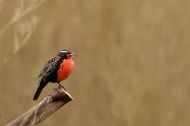Long-tailed Meadowlark
Pecho Colorado Grande
Sturnella loyca
Length: 265mm. Sexes slightly unlike. Male: bill with greyish brown to upper part of culmen, lower edge of culmen and mandible pale grey; iris dark brown; eyebrow red in front of eye and white on outer half of eye to side of nape; crown, hind neck and above mostly buffy brown profusely striated blackish brown; central tail feathers blackish brown with transversal bar buffy brown, remainder blackish brown with thin buffy brown subterminal and terminal bars. Lower orbital region, auriculars and sides of neck black; conspicuous white moustache; chin, throat, centre of foreneck and breast scarlet red margined black; sides of breast and flanks grey stained brown with longitudinal blackish bar along feather rachis and fine transversal bars in same colour; belly blackish; undertail coverts blackish with feathers margined whitish grey; underwing coverts and axillaries white. Legs grey.
Average weight: 132.5g. Female: more extensive buffy brown overall, supercilium white; chin and throat whitish buff; the red on the breast covers only the lower portion and is less intense. Young females have very little red and young males resemble females. Considerable plumage variation, especially in males. Some are much redder than others, there are also individuals with profuse whitish mottling on breast. It is easily identified by its red breast, supercilium and moustache, sharply pointed bill, large size and habits. When flying its white underwing coverts are very conspicuous. Habitat and behaviour: it inhabits open fields with scattered shrubs and trees and grasslands in general. It is found in pairs or in groups that in winter may be quite numerous. Markedly terrestrial, an avid walker, the Long-tailed Meadowlark feeds on seeds and worms picked on the ground. It frequents cultivated land; flocks almost always perch on the ground. Even when in pairs, one of them keeps guard on a fence post or shrub. Male and female sing in duet, from an exposed site. The song consists of high-pitched notes; in the Andean region the authors have observed these birds roosting in grassy marshes where they arrive at twilight. The nest is a simple cup amidst bunchgrass. Up to five reddish and brown mottled eggs on a white ground are laid. Range: widespread in Patagonia from Neuquén and Río Negro to Tierra del Fuego, where the race Sturnella loyca loyca occurs, and on Islas Malvinas, where the race Sturnella loyca falklandica, endemic to the archipelago, can be found.
Illustrated Handbook of the Birds of Patagonia
Kindless: Kovacs Family
|









